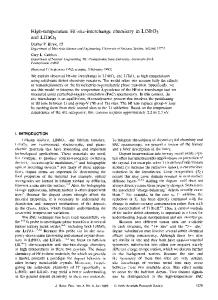Autostoichiometric Mocvd Of Multicomponent Thin Films LiTaO 3 , LiNbO 3 and Sr x Ba 1-x NbO 6
- PDF / 875,392 Bytes
- 6 Pages / 417.6 x 639 pts Page_size
- 30 Downloads / 319 Views
R. Zhang and R. Xu Department of Materials Science and Engineering, College of Engineering, University of Utah, Salt Lake City, Utah 84112 ABSTRACT A novel stoichiometric vapor deposition process, Autostoichiometric MOCVD, was developed in this study to prepare stoichiometric thin films. Heterometallic alkoxides were used as single precursor for two different metal components in Autostoichiometric MOCVD. The molecular ratios of the metals were conserved through the precursor evaporation and the deposition reactions based on the chemical nature of precursors and the deposition reaction mechanisms. A non-stoichiometric factor K was defined to study the evaporation process of precursors. A precursor evaluation method using the K factor and the thermal decomposition analysis was introduced to quantitatively analyze the stoichiometric evaporation characteristic of a heterometallic alkoxide precursor. Single phase LiTaO 3, LiNbO 3, SrNb 20 6 and BaNb 20 6 films were successfully obtained using precursor LiTa(n-OBut) 6 or LiTa(i-OBut) 6, LiNb(n-OBut) 6, SrNb 2(n-OBut)1 2 and BaNb 2(n-OBut)12, respectively. Solid solution Srl-.BaxNb 20 6(SBN) films were also successfully obtained by a two-step Autostoichiometric MOCVD. INTRODUCTION The thin film deposition technology undertook rapid advances in recent years particularly because of their important applications in the semiconductor and microelectronics industry. Among all the physical and chemical film deposition methods, MOCVD technique is presently widely used in the industries of advanced semiconductors, optoelectronics, and photonics. The recent advances in MOCVD technology range from new precursor development [1], delivery [2], better understanding of deposition reaction [3], and better control of the stoichiometry and
microstructure of the oxide films [4-7]. However, the deposition of multicomponent oxides such as ferroelectrics still involves the use of separate metal organic compounds for each metal component. For the fabrication of multicomponent ferroelectric oxides, film composition and stoichiometry control is critical for the film properties, In ordinary MOCVD operations, the precursor compounds are independently transported into the vapor phase, by evaporation or other means, in a controlled manner to achieved the desired molar ratio between vapor phase species. The film stoichiometry is controlled retrospectively after a composition analyses of the deposited films. Adjustments of the deposition conditions, such as the precursor flow rates and the partial
pressure, are enforced after the composition of a previously deposited film is known to effect variation of the film composition. The experimental conditions achieved for the growth of stoichiometric films of a particular multicomponent oxide system is generally not universal among similar apparatus. Consequently, the achievement of exact stoichiometry through such operations has been relatively difficult and time consuming. To further complicate the case, when one of the components in the multicomponent oxi
Data Loading...











